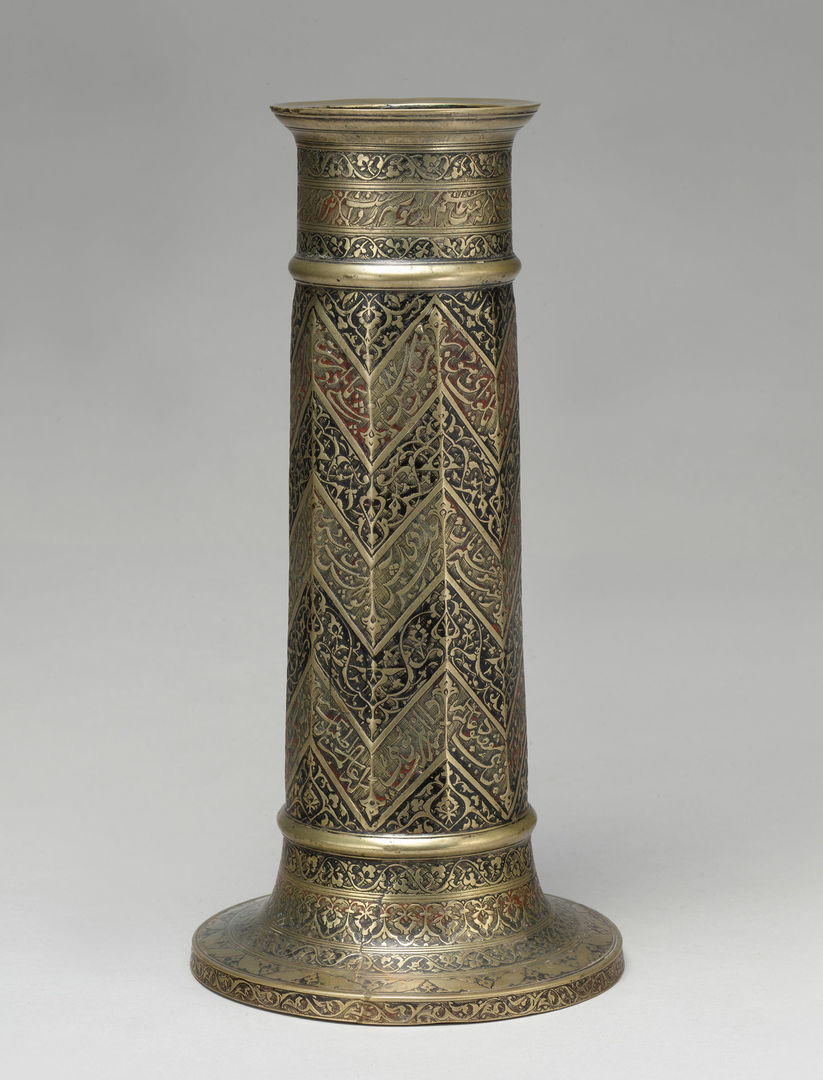Arabic Script and the Art of Calligraphy

Lamp stand with chevron pattern, A.H. 986 / A.D. 1578–79. Iran. Brass; cast, engraved, and inlaid with black and red pigments, 13 1/4 x 6 5/8 in. (33.7 x 16.8 cm). The Metropolitan Museum of Art, New York, Rogers Fund, 1929 (29.53)
Collection Area: Islamic Art
Subject Areas: English Language Arts, Visual Arts
Grades: Middle School, High School
Topic/Theme: Art and Writing
Goals
Students will be able to:
- identify visual qualities of several calligraphic scripts;
- recognize ways artists from the Islamic world engage various scripts to enhance works of art supporting a range of functions; and
- assess the merits of several computer-generated fonts in supporting specific uses.
National Learning Standards
English Language Arts
NL-ENG.K-12.5 Communication Strategies
NL-ENG.K-12.6 Applying Knowledge
Visual Arts
NA-VA.K-12.2 Using Knowledge of Structures and Functions
NA-VA.K-12.6 Making Connections between Visual Arts and Other Disciplines
Common Core State Standards
English Language Arts
CCSS.ELA-Literacy.CCRA.R.1 Read closely to determine what the text says explicitly and to make logical inferences from it; cite specific textual evidence when writing or speaking to support conclusions drawn from the text.
CCSS.ELA-Literacy.CCRA.R.6 Assess how point of view or purpose shapes the content and style of a text.
CCSS.ELA-Literacy.CCRA.SL.2 Integrate and evaluate information presented in diverse media and formats, including visually, quantitatively, and orally.
Questions for Viewing
What function might this object have? What do you see that makes you say that?
- Describe the way the object is decorated. What do the forms remind you of? Why?
- What strategies has this artist used to unify the decoration and the form?
- What aspects of the design do you find most successful? Why?
- Look closely at the bands of calligraphic writing that surround the lamp stand. What adjectives would you use to describe the visual qualities of the script (nasta'liq)? Why?
- Around the shaft are two couplets by the Indian poet Amir Khusrau Dihlavi, each from a different lyric poem (ghazal). Read the following text translated from Persian. How does the content of the text challenge or reinforce your initial impressions of the writing?
There is not a moment that my soul is not
burning from love for you.
Which heart is not burning from that
artful coquetry?
I am burning from jealousy because
you set fire to another.
You set fire to another, yet no one else
is burned but me.
(Translated by Denise-Marie Teece)
Activity
Activity Setting: Classroom
Materials: Paper, pen or pencil, copy of the alphabet (or the same word) in ten or more fonts
Subject Areas: Language Arts, Visual Arts
Duration: Approximately 30–40 minutes
Look at the font choices employed by three different businesses or institutions. What messages or ideas does each font bring to mind? What might you infer about each company based on your observations? If possible, use the Internet to locate the company or institution's mission statement. Compare and contrast the ideals conveyed in the mission statement with your initial impressions of the text. In what ways, if any, do the mission and font align? If you do not feel they make a strong match, consider how you might refine the font to better support the company or institution's mission.
Extension: Collect copies of company or institution mission statements and create a font for one of the selections before looking at the solution posed by their designer.
Alternate Activity
Subject Areas: Language Arts, Visual Arts
Duration: Approximately 30 minutes
As noted in the chart outlining various Arabic calligraphic scripts (see figs. 11, 13, 14), each has distinct visual qualities that align with various functions. Consider how these principles apply across other cultures and languages. Choose five fonts in your language as a focal point for this activity. After looking closely at each example, write a sentence or two describing the visual qualities of each. Share the fonts and your observations with a partner. If you had to match one of your font selections with each of the following functions/purposes, what pairings would you make? Why?
- Job application
- Love poem
- Billboard
- Political message
- Wedding invitation
Resources
Department of Islamic Art. "Calligraphy in Islamic Art." In Heilbrunn Timeline of Art History. New York: The Metropolitan Museum of Art, 2000–.
Ekhtiar, Maryam D., and Claire Moore, eds. Art of the Islamic World: A Resource for Educators. New York: The Metropolitan Museum of Art, 2012.
Objects in the Museum's Collection Related to this Lesson
Mihrab, from a religious school, A.H. 755 / A.D. 1354–55. Iran, Isfahan. Mosaic of polychrome-glazed cut tiles on stonepaste body, set into mortar, 11 ft. 3 1/16 x 9 ft. 5 11/16 in. (343.1 x 288.7 cm), Wt. 4,500 lbs. (2041.2 kg). The Metropolitan Museum of Art, New York, Harris Brisbane Dick Fund, 1939 (39.20)
Bowl with Arabic inscription, 10th century. Iran, Nishapur. Earthenware; white slip with black-slip decoration under transparent glaze, 7 x 18 in. (17.8 x 45.7 cm). The Metropolitan Museum of Art, New York, Rogers Fund, 1965 (65.106.2)
Calligraphic galleon, A.H. 1180 / A.D. 1766–67. Calligrapher: 'Abd al-Qadir Hisari. Turkey. Ink and gold on paper, 19 x 17 in. (48.3 x 43.2 cm). The Metropolitan Museum of Art, New York, Louis E. and Theresa S. Seley Purchase Fund for Islamic Art and Rogers Fund, 2003 (2003.241)
Author: Adapted from lessons by classroom teachers Dr. Sujay Sood and Erin Fitzgerald (2012)